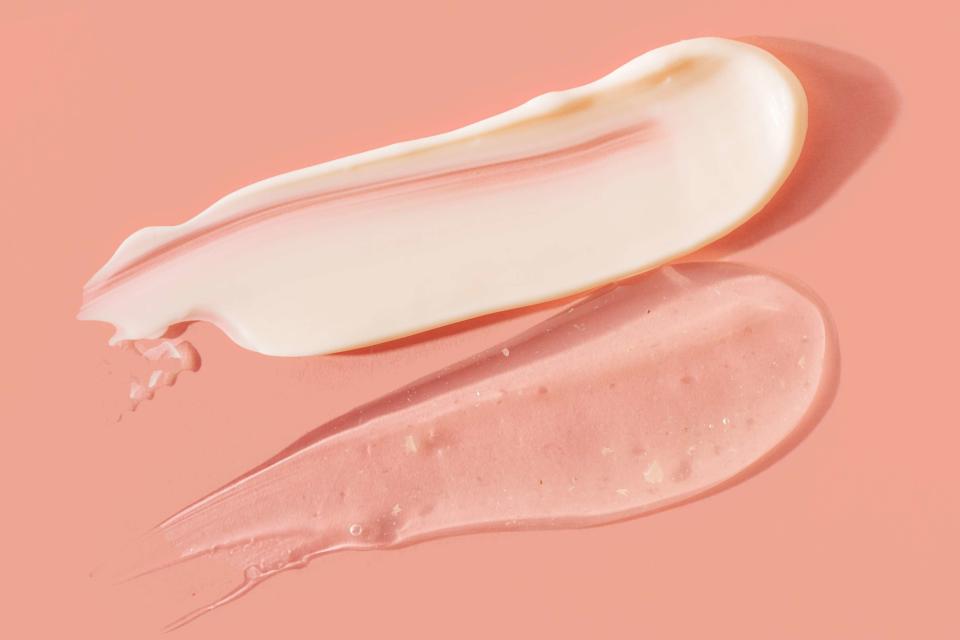Aquaphor vs. Vaseline: What's the Difference?
There's more to it than just the price tag.

Kseniya Ovchinnikova/Getty Images
If you're looking for a potent moisturizer to deal with dry hands, lips, or other body parts, Aquaphor and Vaseline may top your list of go-tos. Both are occlusive moisturizers, meaning that seal in moisture to help head off dry scaly skin. But even though they look and behave similarly, there are significant differences between Aquaphor vs. Vaseline.
Related: 10 Clever Uses for Aquaphor, According to Derms
Get the scoop on these two dermatologist favorite moisturizers, when to use them, and a few potential issues that could crop up from using them.
What's in Vaseline vs. Aquaphor?
Both Aquaphor and Vaseline have a similar clear, thick, and somewhat greasy look and feel, but there are differences in their formulations. "Both products are primarily petrolatum-based products," says Mona Mislankar, MD, FAAD, a dermatologist in Cincinnati, Ohio. "Vaseline’s petrolatum jelly is a pure 100 percent petrolatum with no additional ingredients, while Aquaphor contains 41 percent petrolatum with other humectants and natural barrier lipids such as mineral oil, ceresin, lanolin alcohol, panthenol, glycerin, and bisabolol."
While the petrolatum in each product helps seal in moisture, the additional ingredients in Aquaphor bring additional benefits, "These ingredients give Aquaphor not just occlusive properties, but also humectant (glycerin) and emollient (lanolin) benefits, along with soothing effects (bisabolol), making it a more comprehensive skin care product," says Divya Shokeen, MD, FAAD, a dermatologist at Ocean Skin and Vein Institute in Manhattan Beach, California.
How to Use Aquaphor and Vaseline
Aquaphor and Vaseline can be an affordable—and valuable—addition to your skin care arsenal. "The beauty of these products are they are incredibly multipurpose," Mislankar says. Here's a quick look at a few of the ways you can use them, according to Mislankar and Shokeen.
Always apply Aquaphor or Vaseline onto clean skin
"When using either of these products, it's crucial to apply them on clean skin to prevent trapping any bacteria or non-beneficial agents under the layer of product," Shokeen says. Applying to dirty skin could lead to infection, breakouts, or rashes.
Moisturizing dry skin
Odds are, if you have a tub of Vaseline or Aquaphor around, this is what you bought it for. Applying these ointments to dry, cracked areas can help trap moisture in and soothe your skin. It's especially great for thicker-skinned areas like your heels, or areas that easily become chapped and painful, like your hands or your lips. You can also use them to help seal and soften your cuticles pre-manicure.
Related: 8 Simple Ways to Heal Dry Skin Overnight, According to Derms
Depending on how dry your skin is, Aquaphor may be a better choice for helping with dry skin. "The added ingredients in Aquaphor offer multifaceted skin benefits, including moisturization, healing acceleration, and soothing of irritation, which Vaseline lacks," Shokeen says.
Wound care
A thin layer of Aquaphor or Vaseline can be applied to help soothe and protect minor cuts or scrapes. "Many dermatologists including myself often recommend both for wound care in and outside clinic," Mislankar says.
Skin slugging
Skin slugging has been a popular TikTok beauty trend for years—and involves placing a layer of Aquaphor or Vaseline on after your other beauty products to help seal them in overnight (along with the moisture). The treatment gets its name from the very shiny look to your skin after you've done it—almost like a slug's slime.
Related: Here's What Dermatologists Have to Say About the Skincare Slugging Trend
Makeup remover
Both Vaseline and Aquaphor can help you easily remove makeup—even waterproof makeup! Just apply a little to your skin and rub in a circular motion to remove your makeup.
Diaper cream
As an occlusive moisturizer, petrolatum-based products like Aquaphor and Vaseline can not only help lock in moisture, but it can help provide a barrier so a baby's skin doesn't become irritated by urine or poop.
Chafing prevention
The ointment can help provide a barrier that keeps skin from rubbing and developing redness or inflammation.
Curing flyaways
You can use a tiny bit of either Vaseline or Aquaphor to help tame flyaway hairs or unruly brows.
Caring for eczema or atopic dermatitis
Occlusive ointments like Aquaphor and Vaseline can help restore the moisture barrier in the dry and damaged skin of people dealing with eczema. (And because they have limited ingredients, they're usually well tolerated by people who have skin sensitivities.)
Aquaphor in particular can be helpful, Shokeen says. "Aquaphor, due to its additional ingredients, can be more effective in promoting healing, making it suitable for treating severely dry skin and eczema flareups. The additional benefits may justify the higher price tag of Aquaphor as it could lead to potentially better and faster outcomes."
Related: 44 Genius Vaseline Uses for Your Beauty Routine
Who Shouldn't Use Aquaphor or Vaseline?
While both Aquaphor and Vaseline are excellent moisturizers, some people may want to reconsider using them for certain applications or if you're predisposed to certain allergies.
Avoid Aquaphor if you have a wool allergy
"Aquaphor does contain lanolin—a wool alcohol," Mislankar says. "If one has an allergic contact dermatitis to lanolin, this could be displayed as an allergic reaction to Aquaphor."
Skip the slugging if you're acne-prone
Skin slugging to create a glowing complexion has been a popular beauty treatment, but Mislankar recommends skipping the slug if you're acne prone—even though both Aquaphor and Vaseline are non-comedogenic, meaning that they don't clog your pores. "The slugging technique can be very beneficial as a moisturizing technique, especially for someone with very dry skin," she says. "However, if you are particularly acne-prone, slugging with an occlusive product traps oil and residue onto the skin, which could promote for acneiform lesions."
For more Real Simple news, make sure to sign up for our newsletter!
Read the original article on Real Simple.

